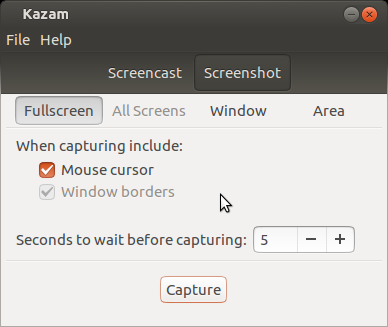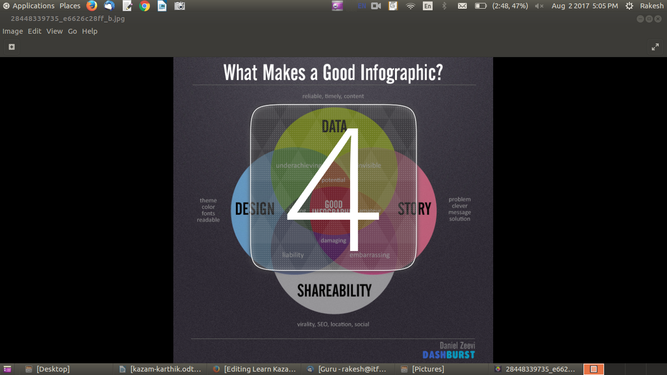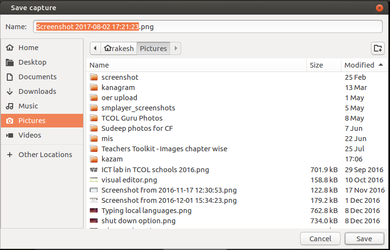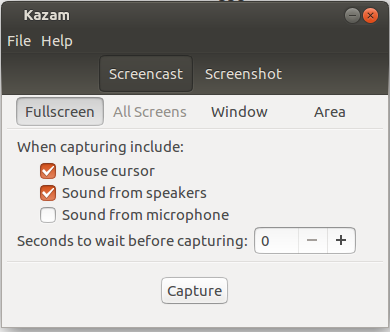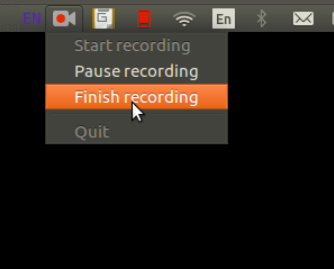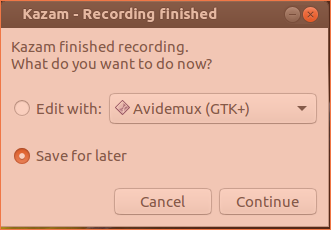"कज़म सीखिए" के अवतरणों में अंतर
| पंक्ति ४०: | पंक्ति ४०: | ||
##एकबार विंडो पेज़ खुल गया,तो डॉलर के प्रतीक($) के सामने नीचे दिया गया कमांड टाइप करें। | ##एकबार विंडो पेज़ खुल गया,तो डॉलर के प्रतीक($) के सामने नीचे दिया गया कमांड टाइप करें। | ||
##'''sudo apt-get install kazam''' | ##'''sudo apt-get install kazam''' | ||
| − | ## | + | ##अपना पासवर्ड टाइप करें (यह आपके पर्दे पर दिखाई नहीं देगा),प्रवेश दबाएँ। |
| − | |||
| − | ==== | + | === '''अनुप्रयोग के साथ कार्य करना''' === |
| − | + | ||
| − | ==== | + | === प्रिंट स्क्रीन का उपयोग करें === |
| − | + | यह स्क्रीनशॉट लेने की सबसे सामान्य विधि है। "प्रिंट स्क्रीन" बटन दबाने पर "दिखने वाले पूरे पर्दे" का स्क्रीनशॉट आ जाएगा। | |
| + | |||
| + | ==== अनुप्रयोग से परिचित होना ==== | ||
| + | जब हम कज़म खोलते हैं तो हमें यह मुख्य विंडो दिखेगी। इस मुख्य विंडो में निम्नलिखित भाग हैं। अनुप्रयोगों--->Sound and Video--->Kazam से अनुप्रयोग खोलें। | ||
[[File:Kazam home page.png|left|frame|Kazam home page]] | [[File:Kazam home page.png|left|frame|Kazam home page]] | ||
| − | # | + | # स्क्रीनकास्ट: यह विकल्प स्क्रीन-कास्टिंग को व्यवस्थित करने के लिए है। |
| − | # | + | # स्क्रीनशॉट : यह विकल्प स्क्रीनशॉट को व्यवस्थित करने के लिए है। |
| − | # | + | # पूर्णस्क्रीन : इस विकल्प को चुनकर उपयोगकर्ता कंप्यूटर प्रदर्शन के पूरे स्क्रीन का स्क्रीनकास्ट/स्क्रीनशॉट करने में सक्षम हो सकता है। यह तरीका ट्यूटोरियल बनाने के लिए उपयोगी है जहाँ आपको डेस्कटॉप प्रबंधक और विभिन्न विंडो तथा अनुप्रयोगों के बीच पारस्परिक क्रिया दिखाने की आवश्यकता होती है। |
| − | # | + | # विंडो :यह विकल्प चुनकर, उपयोगकर्ता अपने कंप्यूटर स्क्रीन की केवल वर्तमान विंडो के स्क्रीनकास्ट/स्क्रीनशॉट करने में सक्षम हो सकता है। यह तरीका जो केवल एक विशेष विंडो को रिकॉर्ड करता है, एक अनुप्रयोग के स्क्रीनकास्टों को रिकॉर्ड करने के लिए आदर्श है। |
| − | # | + | # क्षेत्र : यह विकल्प चुनकर, उपयोगकर्ता अपने कंप्यूटर स्क्रीन के केवल चयनित क्षेत्र के स्क्रीनकास्ट/स्क्रीनशॉट करने में सक्षम हो सकता है। माउस कर्सर : अपनी स्क्रीनकास्ट/स्क्रीनशॉट आउटपुट फाइल में कर्सर प्वाइंट शामिल करने के लिए इस विशेषता का चयन करें। |
| − | # | + | # स्पीकर से ध्वनि : अपने स्क्रीनकास्टिंग के साथ स्पीकर आउटपुट ऑडियो जोड़ने के लिए इस विशेषता का चयन करें। |
| − | # | + | # माइक्रोफोन से ध्वनि : अपने स्क्रीनकास्टिंग के साथ अपने स्वयं के ऑडियो जोड़ने (माइक्रोफोन का उपयोग करके) के लिए इस विशेषता का चयन करें। |
| − | # | + | # कैप्चरिंग से पहले प्रतीक्षा के लिए सेकंड : Select this feature for adding your own audio (by using microphone) with our screencasting. |
# Seconds to wait before capturing : This will allow us to delay to start the capture. | # Seconds to wait before capturing : This will allow us to delay to start the capture. | ||
# Capture : This option is to start screencast/scheenshot. | # Capture : This option is to start screencast/scheenshot. | ||
१७:०६, ११ जुलाई २०१८ का अवतरण
परिचयमूलभूत जानकारी
विशेषताओं का संक्षिप्त-परिचयस्थापना
अनुप्रयोग के साथ कार्य करनाप्रिंट स्क्रीन का उपयोग करेंयह स्क्रीनशॉट लेने की सबसे सामान्य विधि है। "प्रिंट स्क्रीन" बटन दबाने पर "दिखने वाले पूरे पर्दे" का स्क्रीनशॉट आ जाएगा। अनुप्रयोग से परिचित होनाजब हम कज़म खोलते हैं तो हमें यह मुख्य विंडो दिखेगी। इस मुख्य विंडो में निम्नलिखित भाग हैं। अनुप्रयोगों--->Sound and Video--->Kazam से अनुप्रयोग खोलें।
Getting start with simple screenshotWhen user launch the application, user will notice that in addition to recording screencast, user can also use the application to take screenshots, by switching to it at the top. After user opens kazam from menu, just click on the Screenshot option to take capture your computer screen as image. Here user can take screenshot in three modes like full screen, select window and select area. Users can choose
If users choose Area option, they have to drag cursor along particular area. Also users can choose whether to keep their Mouse cursor in their Screenshot and can choose to set capturing delay by few seconds before they actually start their Screenshot. NOTE:- These options are same for both Screenshot and Screencast. Saving screenshotAfter selecting above options users can click on Capture to take Screenshot. It will prompt users to choose location for save your screenshot. Users can also change the file name before saving. Getting start with Screen casting your computer screenThis works similar to Screenshot except that it helps users to record their computer screens along with audio and save them as videos. Here also users can choose whether to keep their Mouse cursor in their Screencast recording, also they can choose to record Sounds from speakers (computer audio output) and Sounds from microphone (record users input through microphone) in their recording which will help users to use their own voice or music from other sources. Also users can choose to set capturing delay by few seconds before they actually start their recording. After selecting above options users can click on Capture to begin Screencast. Saving/exporting screencastAfter recording a screen, users can click on Finish recording which will prompt users to choose edit it further using any video editing tools or to Save for later to save this video in computer. Ideas for resource creation
References |
